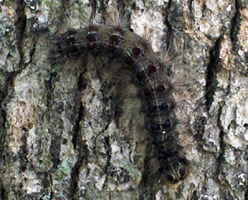NJ GYPSY MOTH POPULATIONS DECLINE
NJDA Aerial Survey Shows Less Tree Damage Over Last Year
For Immediate Release: July 17, 2014
Contact: Lynne Richmond
(609) 633-2954
lynne.richmond@ag.state.nj.us
(TRENTON) – New Jersey Secretary of Agriculture Douglas H. Fisher today announced the amount of tree damage caused by gypsy moth caterpillars this year was less than half of what it was last year and was mostly concentrated in the northern counties.
The New Jersey Department of Agriculture’s annual statewide gypsy moth aerial defoliation survey showed 1,330 acres of trees in 24 municipalities in 11 counties were defoliated, as compared to 2013 when 2,887 acres of trees in 51 towns in 17 counties were damaged.
“For the last five years, New Jersey has experienced very substantially less gypsy moth damage through a combination of favorable weather conditions, an army of beneficial insects and intense surveillance,” said Secretary Fisher. “We will continue our work, along with the Department of Environmental Protection, to protect the state’s trees from being devastated by the gypsy moth caterpillar.”
The defoliation survey was conducted in late June and early July. Tree damage was centered in Morris, Passaic, Bergen and Sussex counties, which sustained 1,110 acres of tree damage. Minimal amounts of damage were seen in Burlington, Camden, Hunterdon, Mercer, Middlesex, Ocean and Warren Counties. For more details from the survey, go to www.nj.gov/agriculture/divisions/pi/pdf/2014gmsurvey.pdf.
Gypsy moth populations can be cyclical. Tree damage from the insects reached a high of 339,240 in 2008, but through the combination of the Department’s aggressive spray program, a number of beneficial insects and weather that supported a fungus that impacts gypsy moths, populations have collapsed over the last several years. There was a record low in 2012, when only 1,068 acres of trees sustained damage from the leaf-eating pests.
The Department of Agriculture will conduct an egg mass survey this fall to determine where spraying might be warranted.
Gypsy moth caterpillars lay their eggs on trees and emerge in May and early June. This year, no spray program was needed due to low populations of the bugs.
To qualify for the spray program, a residential or recreational forest must have an average of more than 500 egg masses per acre and be at least 50 acres in size. A single egg mass contains up to 1,000 eggs.
Vigilance is necessary for continued success of the program. Two to three consecutive years of significant defoliation (defined as 75 percent or more) can kill an otherwise healthy tree. However, any gypsy moth defoliation can make trees more susceptible to other damage that can lead to the death of the tree. Oak trees are the preferred host for gypsy moths, but the caterpillars can be found feeding on almost any tree in the vicinity.
For more information on New Jersey’s gypsy moth suppression program, visit: www.nj.gov/agriculture/divisions/pi/prog/gypsymoth.html. Also, for national gypsy moth material, visit www.na.fs.fed.us/fhp/gm/.



